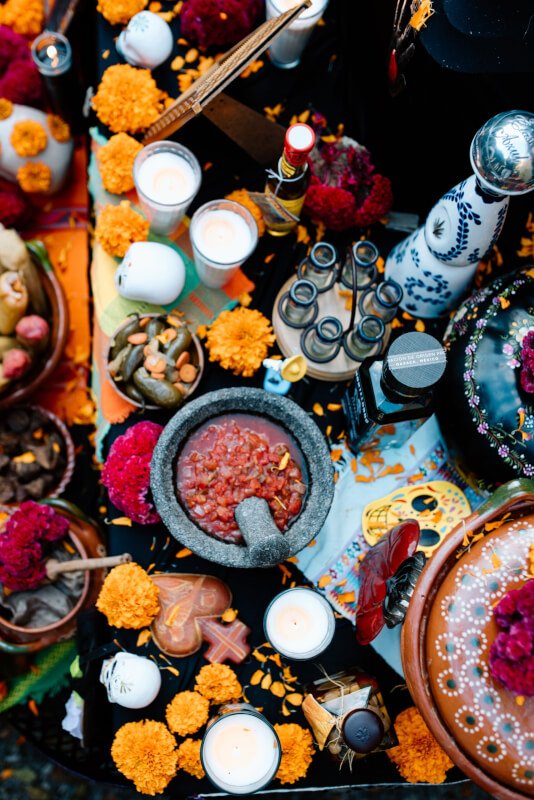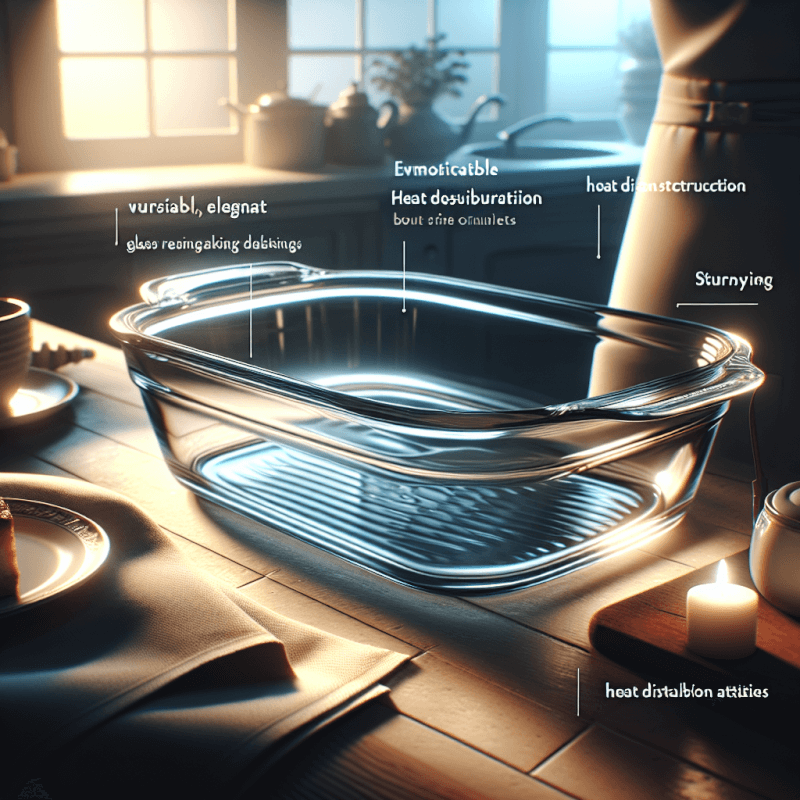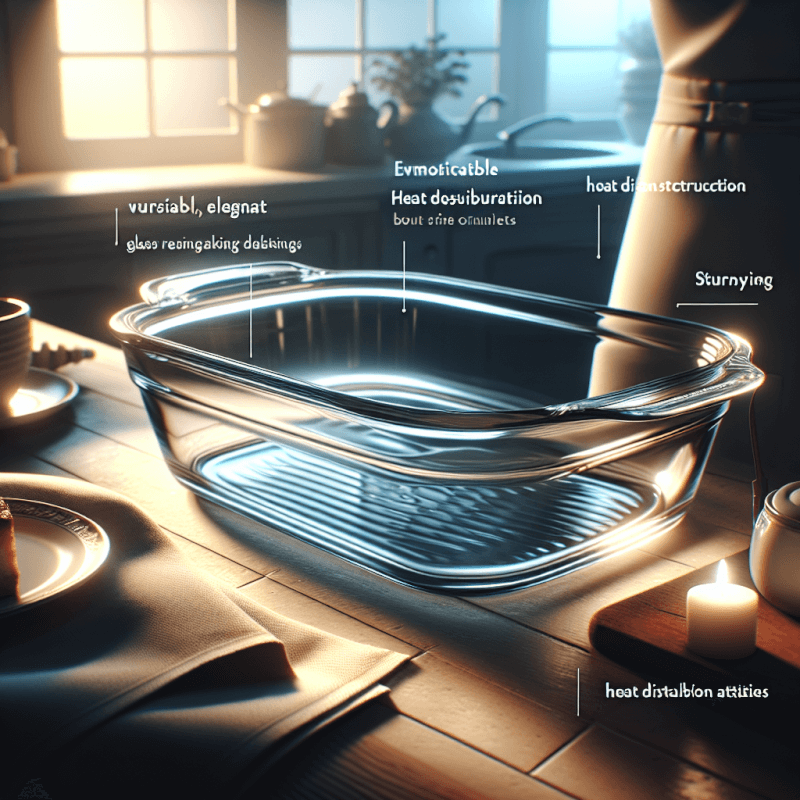Are you tired of constantly having to replace your worn-out bakeware? Look no further than bakeware glass, the versatile and durable solution for all your baking needs. With its heat-resistant properties, this glassware ensures even cooking and browning, leaving your treats perfectly baked every time. Say goodbye to burnt edges and uneven centers, and say hello to delicious, evenly cooked desserts. Whether you’re a professional baker or just enjoy whipping up sweet treats at home, bakeware glass is a must-have addition to your kitchen. Upgrade your baking experience and elevate the presentation of your culinary creations with bakeware glass today.

1. What is Bakeware Glass
1.1 Introduction to Bakeware Glass
Bakeware glass refers to a type of glass material that is specifically designed for use in cooking and baking. It is commonly used for making various dishes such as casseroles, pies, and baked goods. Bakeware glass is known for its heat resistance, durability, and versatility, making it a popular choice among home cooks and professional chefs alike. Whether you’re a beginner or an experienced cook, bakeware glass can be a valuable addition to your kitchen arsenal.
1.2 Benefits of Bakeware Glass
There are several key benefits to using bakeware glass in your kitchen. One major advantage is its ability to withstand high temperatures without shattering or warping. Unlike other materials, such as metal or silicone, bakeware glass can be safely used in the oven at high temperatures without the risk of any chemical reactions or harmful fumes. Additionally, bakeware glass is non-porous, meaning it won’t absorb flavors or odors from your food, ensuring that your dishes maintain their true taste and aroma.
Another benefit of bakeware glass is its versatility. It can be used for both sweet and savory dishes, making it perfect for a wide range of recipes. Whether you’re baking a batch of cookies or roasting vegetables, bakeware glass provides even heat distribution, resulting in consistent and delicious results. Furthermore, bakeware glass is often designed with stylish and aesthetically pleasing shapes, making it a beautiful addition to your table when serving your dishes.
1.3 Common Types of Bakeware Glass
There are several common types of bakeware glass available on the market. One popular option is glass baking dishes, which come in various sizes and shapes to suit different recipes. Glass pie plates are another common type of bakeware glass, especially ideal for creating flaky and perfectly browned pie crusts. Glass casserole dishes, often with accompanying lids, are also widely used for making comforting and flavorful casseroles that can easily go from oven to table. These are just a few examples of the many options available when it comes to bakeware glass.
2. Advantages of Using Bakeware Glass
2.1 Heat Resistance
One of the major advantages of bakeware glass is its exceptional heat resistance. Glass is a poor conductor of heat, meaning it retains heat evenly and effectively. This allows for even cooking and prevents hot spots, ensuring your food is cooked to perfection. Bakeware glass can safely withstand high temperatures, making it suitable for use in ovens, microwaves, and even freezers. Whether you’re baking, roasting, or reheating, you can rely on bakeware glass to deliver consistent and reliable results.
2.2 Versatility
Bakeware glass is highly versatile and can be used for a wide range of cooking and baking applications. From casseroles and lasagnas to pies and cakes, bakeware glass can handle it all. Its ability to withstand a variety of temperatures makes it a convenient choice for busy kitchens. You can seamlessly transition from baking a dessert to roasting vegetables without having to switch pans. Additionally, many bakeware glass products are designed to be visually appealing and can be used for serving directly from the oven to the table, adding a touch of elegance to your meal presentation.
2.3 Non-reactive Material
Another advantage of bakeware glass is its non-reactive nature. Unlike some metal or ceramic pans, bakeware glass does not react with acidic or alkaline ingredients. This means that your dishes will not be compromised by any metallic or chemical flavors, ensuring the integrity of your recipes. Whether you’re cooking a tomato-based sauce or baking a lemon tart, you can trust that bakeware glass will preserve the flavors and colors of your dishes.
3. Popular Bakeware Glass Products
3.1 Glass Baking Dishes
Glass baking dishes are a staple in many kitchens. They come in various sizes and shapes, allowing you to choose the perfect one for your recipe. Whether you’re making a small casserole or a large lasagna, there is a glass baking dish to suit your needs. These dishes are often designed with sturdy handles for easy handling and transport. Glass baking dishes are versatile, durable, and can easily withstand high temperatures for extended periods of time, ensuring that your dishes are cooked evenly and thoroughly.
3.2 Glass Pie Plates
If you love baking pies, a glass pie plate is a must-have in your bakeware collection. Glass pie plates allow for even browning of the crust and a crisp, flaky texture. The transparency of the glass also allows you to monitor the browning process, ensuring that your pie is perfectly cooked. Glass pie plates are available in various sizes, making it easy to find one that fits your recipe. With a glass pie plate, you can confidently bake beautiful and delicious pies every time.
3.3 Glass Casserole Dishes
Glass casserole dishes are perfect for making comforting and flavorful casseroles. These dishes often come with accompanying lids, allowing you to easily transport and store your dishes. They are available in different shapes and sizes to accommodate a variety of recipes. Glass casserole dishes are also great for slow-cooking dishes, as they can be used on the stovetop, in the oven, or even in the microwave. With a glass casserole dish, you can effortlessly create and serve delicious casseroles that will impress your family and guests.
4. How to Choose the Right Bakeware Glass
4.1 Size and Capacity
When choosing bakeware glass, it’s important to consider the size and capacity that will best suit your needs. Evaluate the size of your oven and the amount of food you typically cook to determine the appropriate dimensions for your bakeware glass. Think about the recipes you often make and choose a size that will accommodate them. Additionally, consider the number of servings you usually need to prepare. It’s better to have bakeware glass that is slightly larger than needed, as you can always adjust the quantity of ingredients accordingly.
4.2 Shape and Design
Bakeware glass comes in a variety of shapes and designs, each with its own benefits. Consider the shape that would be most practical for the types of dishes you commonly make. Rectangular or square pans are great for lasagnas and casseroles, while round or oval pans are ideal for pies and quiches. Additionally, think about the depth of the bakeware glass. Deeper dishes are suitable for layered dishes, while shallower ones are better for creating a crispy crust on baked goods. Lastly, consider the design and aesthetics of the bakeware glass. Choose a style that matches your kitchen and personal preferences.
4.3 Lid Options
Some bakeware glass products come with accompanying lids, which can be extremely useful for transporting and storing your dishes. Lids help to preserve the freshness and flavors of your food, allowing you to prepare meals in advance or store leftovers. If you anticipate needing to transport or store your dishes, consider bakeware glass with compatible lids. However, keep in mind that lids may not be necessary for all types of recipes, and they can take up additional space in your kitchen cabinets.

5. Tips for Proper Use and Care
5.1 Preparing Glass Bakeware
Before using your bakeware glass for the first time, it’s important to wash it thoroughly with warm, soapy water. This will remove any residue from the manufacturing process. Rinse the bakeware glass well and dry it thoroughly before use. Additionally, it’s a good idea to lightly grease the glass with a cooking spray or butter before adding your ingredients. This will help prevent food from sticking to the glass and make cleanup easier.
5.2 Temperature Considerations
When using bakeware glass, it’s important to follow the temperature guidelines provided by the manufacturer. While bakeware glass is generally safe for use at high temperatures, extreme temperature changes can cause the glass to shatter. Avoid placing cold or frozen dishes directly into a preheated oven, and do not place hot bakeware glass on a cool countertop. Always allow the glass to cool down gradually to reduce the risk of thermal shock.
5.3 Cleaning and Storing Glass Bakeware
Cleaning bakeware glass is usually a straightforward process. After use, allow the bakeware glass to cool completely before washing it. Avoid exposing hot glass to cold water, as this can cause the glass to shatter. Use a mild dish soap and a soft sponge or brush to clean the glass. Avoid using abrasive cleaners or scouring pads that could scratch the surface of the glass. Rinse the glass thoroughly and dry it with a soft cloth.
When storing your bakeware glass, ensure it is completely dry to prevent any moisture from accumulating. Store the glass in a cool and dry place, away from direct sunlight or extreme temperature fluctuations. It is advisable to stack the glass bakeware with care, using protective padding or cloth between each piece to prevent scratching or chipping.
6. Common Questions about Bakeware Glass
6.1 Is Bakeware Glass Dishwasher Safe?
Most bakeware glass is dishwasher safe, but it’s always best to consult the manufacturer’s instructions to be sure. Some bakeware glass may be marked as dishwasher safe but could still benefit from handwashing to maintain its longevity and appearance. Additionally, handwashing allows you to inspect the glass for any cracks or chips that may have occurred during use.
6.2 Can Bakeware Glass Go in the Microwave?
Yes, bakeware glass is safe to use in the microwave. Its heat resistance allows it to handle the rigors of microwave cooking without any issues. However, always ensure that the glass is microwave-safe and follow the manufacturer’s instructions for proper use. Remember to use microwave-safe covers or lids when heating food in bakeware glass to prevent splatters and retain moisture.
6.3 Can You Freeze Bakeware Glass?
Yes, bakeware glass is freezer safe and can be used to freeze both cooked and uncooked dishes. Freezing food in bakeware glass is a convenient way to prepare meals in advance or store leftovers. However, it’s important to note that drastic temperature changes can cause the glass to crack, so it’s best to allow the dish to cool down before placing it in the freezer. Additionally, be mindful of how long you store frozen dishes in bakeware glass, as extended periods of time can affect the quality and flavor of the food.

7. Bakeware Glass vs. Other Materials
7.1 Bakeware Glass vs. Metal
Compared to metal, bakeware glass offers several advantages. While metal pans can conduct heat quickly, they can also lead to uneven heating and potential burning of the food. Bakeware glass, on the other hand, distributes heat evenly, resulting in perfectly cooked dishes. Glass is also a non-reactive material, meaning it won’t affect the flavors of your food. Metal pans, particularly those with non-stick coatings, can scratch easily and require careful cleaning and maintenance. Bakeware glass, with its smooth and non-porous surface, is easier to clean and maintain.
7.2 Bakeware Glass vs. Silicone
Silicone bakeware has gained popularity in recent years due to its flexibility and non-stick properties. While silicone can be a convenient choice for certain recipes, bakeware glass offers its own set of advantages. Glass bakeware provides superior heat retention and even heating, resulting in more consistent and predictable baking outcomes. Silicone bakeware may not provide the same level of browning or crisping as glass bakeware. Furthermore, bakeware glass is more durable and long-lasting compared to silicone, which can be prone to tearing, melting, or losing its shape over time.
7.3 Bakeware Glass vs. Ceramic
Ceramic bakeware shares some similarities with bakeware glass, as both materials offer even heat distribution and aesthetically pleasing designs. However, there are a few key differences to consider. Bakeware glass is generally more heat resistant than ceramic, allowing for higher oven temperatures and more versatile cooking options. Glass is also non-porous, making it easier to clean and preventing the absorption of odors or flavors. Ceramic bakeware, on the other hand, may require more careful handling and storage to prevent chipping or cracking. Ultimately, the choice between bakeware glass and ceramic depends on personal preferences and the specific needs of your recipes.
8. Recipes and Cooking Tips Using Bakeware Glass
8.1 Classic Lasagna Recipe
Ingredients:
- 1 pound ground beef
- 1 onion, diced
- 4 cloves garlic, minced
- 1 can (28 ounces) crushed tomatoes
- 1 can (6 ounces) tomato paste
- 1 teaspoon dried basil
- 1 teaspoon dried oregano
- Salt and pepper to taste
- 9 lasagna noodles, cooked
- 2 cups shredded mozzarella cheese
- 1 cup grated Parmesan cheese
- Fresh basil leaves for garnish
Instructions:
- Preheat the oven to 375°F (190°C). Heat a large skillet over medium heat and cook the ground beef, onion, and garlic until the beef is browned and the onion is softened.
- Stir in the crushed tomatoes, tomato paste, dried basil, dried oregano, salt, and pepper. Simmer the sauce for about 15 minutes, allowing the flavors to meld together.
- In a glass baking dish, spread a thin layer of the sauce on the bottom. Arrange three lasagna noodles on top of the sauce.
- Repeat the layers, alternating with the sauce, noodles, and cheese. Finish with a layer of sauce and sprinkle the Parmesan cheese on top.
- Cover the baking dish with aluminum foil and bake for 25 minutes. Remove the foil and bake for an additional 15 minutes, or until the cheese is melted and bubbly.
- Allow the lasagna to cool for a few minutes before serving. Garnish with fresh basil leaves and enjoy!
8.2 Roasted Vegetable Casserole
Ingredients:
- 2 zucchinis, sliced
- 2 yellow squash, sliced
- 2 bell peppers, sliced
- 1 red onion, sliced
- 1 cup cherry tomatoes
- 3 tablespoons olive oil
- 2 cloves garlic, minced
- 1 teaspoon dried thyme
- Salt and pepper to taste
- 1 cup shredded cheddar cheese
- Fresh parsley leaves for garnish
Instructions:
- Preheat the oven to 425°F (220°C). In a large bowl, toss the zucchinis, yellow squashes, bell peppers, red onion, and cherry tomatoes with olive oil, minced garlic, dried thyme, salt, and pepper.
- Spread the vegetables in a glass casserole dish. Make sure they are in a single layer for even roasting.
- Roast the vegetables in the preheated oven for about 25-30 minutes, or until they are tender and slightly caramelized.
- Remove the dish from the oven and sprinkle the shredded cheddar cheese on top of the roasted vegetables. Return the dish to the oven for another 5 minutes, or until the cheese is melted and bubbly.
- Remove from the oven and let it cool for a few minutes before serving. Garnish with fresh parsley leaves and enjoy this flavorful and healthy vegetable casserole.
8.3 Apple Pie with Glass Crust
Ingredients:
- 6 cups peeled and sliced apples (such as Granny Smith or Honeycrisp)
- 3/4 cup granulated sugar
- 2 tablespoons all-purpose flour
- 1 teaspoon ground cinnamon
- 1/4 teaspoon ground nutmeg
- 1/4 teaspoon salt
- 2 tablespoons lemon juice
- 1 tablespoon unsalted butter, diced
- 1 package refrigerated pie crusts (2 crusts)
- 1 tablespoon milk
- 1 tablespoon granulated sugar
Instructions:
- Preheat the oven to 425°F (220°C). In a large bowl, combine the sliced apples, granulated sugar, flour, cinnamon, nutmeg, salt, and lemon juice. Toss until the apples are well coated and set aside.
- Place one of the refrigerated pie crusts into a glass pie plate, pressing it into the bottom and up the sides of the plate. Trim any excess crust hanging over the edges.
- Pour the apple mixture into the pie crust. Dot the top of the filling with the diced butter.
- Lay the second pie crust over the apple filling. Trim any excess and crimp the edges of the crust to seal the pie. Cut a few small slits in the top crust to allow steam to escape.
- Brush the top crust with milk and sprinkle with granulated sugar.
- Place the pie plate on a baking sheet to catch any drips during baking. Bake the pie in the preheated oven for 40-50 minutes, or until the crust is golden brown and the filling is bubbly.
- Remove the pie from the oven and let it cool for at least 2 hours before serving to allow the filling to set. Serve slices of apple pie with a scoop of vanilla ice cream or whipped cream for a delicious and classic dessert.

9. Top Brands and Where to Buy Bakeware Glass
9.1 Pyrex
Pyrex is a well-known brand that has been producing high-quality bakeware glass for many years. Their products are known for their durability, heat resistance, and versatility. Pyrex offers a wide range of bakeware glass options, including baking dishes, pie plates, and casserole dishes. You can find Pyrex bakeware glass products at major retailers such as Walmart, Target, and Bed Bath & Beyond.
9.2 Anchor Hocking
Anchor Hocking is another reputable brand that specializes in bakeware glass. They offer a variety of bakeware glass products, all made with high-quality materials and craftsmanship. Anchor Hocking’s bakeware glass is known for its excellent heat resistance and stylish designs. You can purchase Anchor Hocking bakeware glass at stores like Amazon, Macy’s, and Williams Sonoma.
9.3 Corningware
Corningware is a trusted brand that has been producing bakeware glass since the 1950s. Their products are renowned for their versatility and durability. Corningware bakeware glass can be used in the oven, microwave, and even on the stovetop. They offer a range of sizes and styles, making it easy to find the perfect bakeware glass for your cooking needs. Corningware products are available at stores like Bed Bath & Beyond, Kohl’s, and JCPenney.
10. Conclusion
Bakeware glass is a versatile and reliable choice for all your cooking and baking needs. Its heat resistance, versatility, and non-reactive properties make it a popular material among home cooks and professional chefs alike. With a wide range of bakeware glass products available, such as baking dishes, pie plates, and casserole dishes, you can easily find the perfect pieces for your recipes. By choosing the right size, shape, and design, as well as properly using and caring for your bakeware glass, you can create delicious dishes with ease. Whether you’re making lasagna, roasting vegetables, or baking a pie, bakeware glass is a valuable addition to any kitchen. So why not give it a try and elevate your cooking and baking experience?



